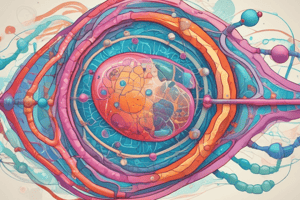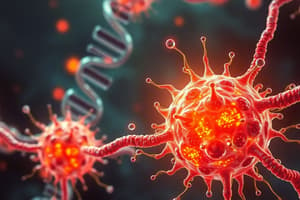Podcast
Questions and Answers
Which of the following are mechanisms that control gene expression in eukaryotes? (Select all that apply)
Which of the following are mechanisms that control gene expression in eukaryotes? (Select all that apply)
- Gene duplication
- Transcription (correct)
- mRNA transportation (correct)
- Protein regulation (correct)
What is the role of the nucleolus?
What is the role of the nucleolus?
It is a clump of ribosomal genes that make rRNA.
True or False: Open chromatin is also known as heterochromatin.
True or False: Open chromatin is also known as heterochromatin.
False (B)
What are chromosome territories?
What are chromosome territories?
____ modification can activate or silence gene expression by adding chemical groups to histone proteins.
____ modification can activate or silence gene expression by adding chemical groups to histone proteins.
What is the effect of histone acetylation?
What is the effect of histone acetylation?
What is the function of the interchromosomal domain?
What is the function of the interchromosomal domain?
Match the following terms with their definitions:
Match the following terms with their definitions:
Define transcription factory.
Define transcription factory.
Which of the following statements about histone methylation is true?
Which of the following statements about histone methylation is true?
Flashcards are hidden until you start studying
Study Notes
Gene Regulation in Eukaryotes
- Eukaryotic gene expression is controlled through multiple mechanisms, including transcription, mRNA processing, transport, storage, translation, and protein modification.
- Unique features of eukaryotic cells, such as increased DNA content and histone interactions, enhance gene regulation.
Mechanisms of Gene Regulation
- mRNAs undergo splicing, capping, and polyadenylation, with each step subject to regulation.
- Eukaryotic mRNAs exhibit varied half-lives, enabling adaptive responses to environmental changes.
- Translation rates and post-translational protein processing can be modified for further control.
Ribosomal RNA
- rRNA genes, essential for ribosome formation, are located on afrocentric chromosomes and clustered in the nucleolus.
Chromatin Structure
- Chromatin is formed by nucleosomes wrapped into 30nm fibers, with histones and nonhistone proteins influencing gene accessibility.
- Nucleosomes have protruding polypeptide tails that can be chemically modified, impacting gene regulation.
Chromosome Organization
- In the interphase nucleus, each chromosome exists in a defined territory, separating it from others.
- Active genes are typically located at the edges of these chromosome territories, adjacent to interchromosomal domains.
Transcription Factories
- Transcription factories are nuclear sites housing RNA polymerase and regulatory molecules, facilitating enhanced gene expression by concentrating necessary factors.
Chromatin States
- Open Chromatin (euchromatin) is loosely bound and accessible to transcription factors, allowing gene expression.
- Closed Chromatin (heterochromatin) is tightly compacted, restricting transcription factor access and inhibiting gene expression.
Chromatin Dynamics
- Both active and inactive genes are associated with nucleosomes, with differences in nucleosome conformation linked to transcriptional activity.
Mechanisms of Chromatin Alteration
- Chromatin can be modified through changes in nucleosome composition, histone modifications, and chromatin remodeling, allowing dynamic regulation of gene expression.
Nucleosome Composition
- Variants like H2A.Z within nucleosomes affect positioning and mobility, influencing gene activation or repression at promoters.
Histone Modifications
- Covalent modifications on histone N-terminal tails can activate or deactivate genes; acetylation and methylation are key processes.
- Acetylation reduces histone-DNA affinity, promoting transcription; catalyzed by HATs and reversed by HDACs.
Methylation Effects
- Histone methylation enhances transcription by favoring euchromatin states.
- DNA methylation, on the other hand, silences genes by adding methyl groups to DNA, often observed in hemizygous states like the inactivated X chromosome in females.
Studying That Suits You
Use AI to generate personalized quizzes and flashcards to suit your learning preferences.




